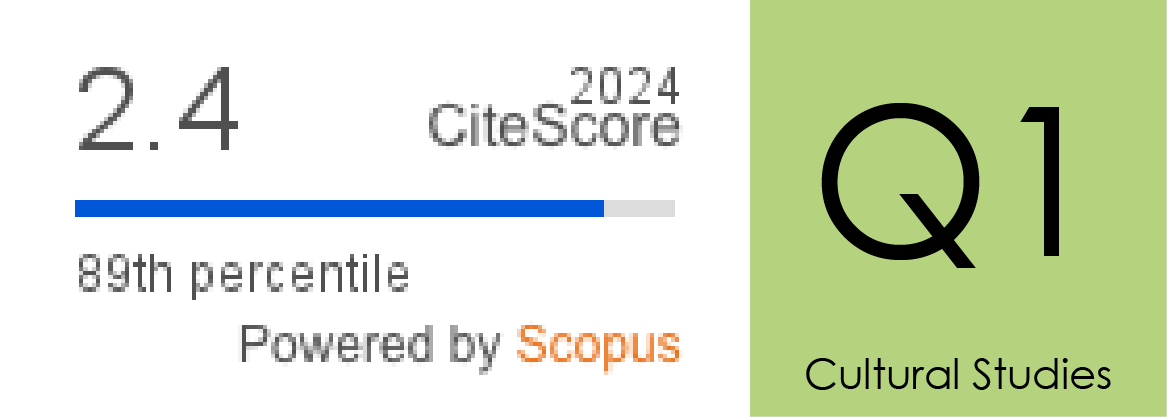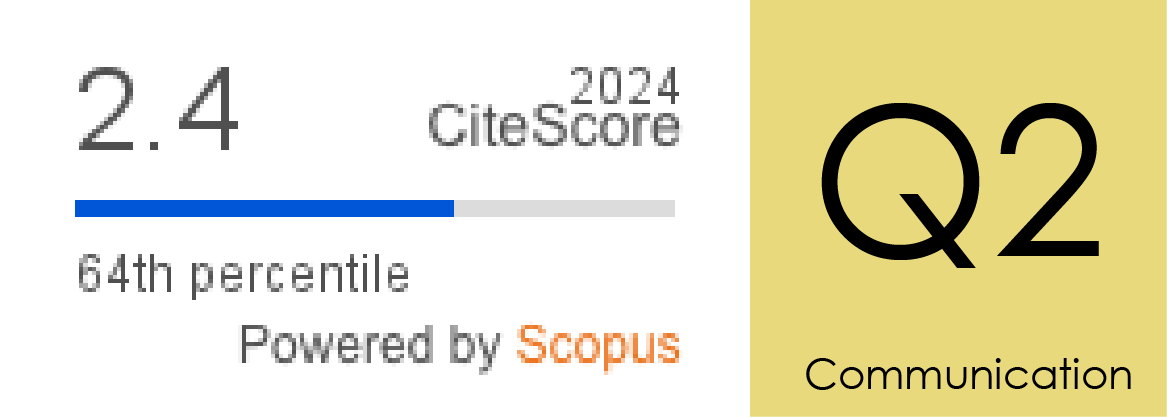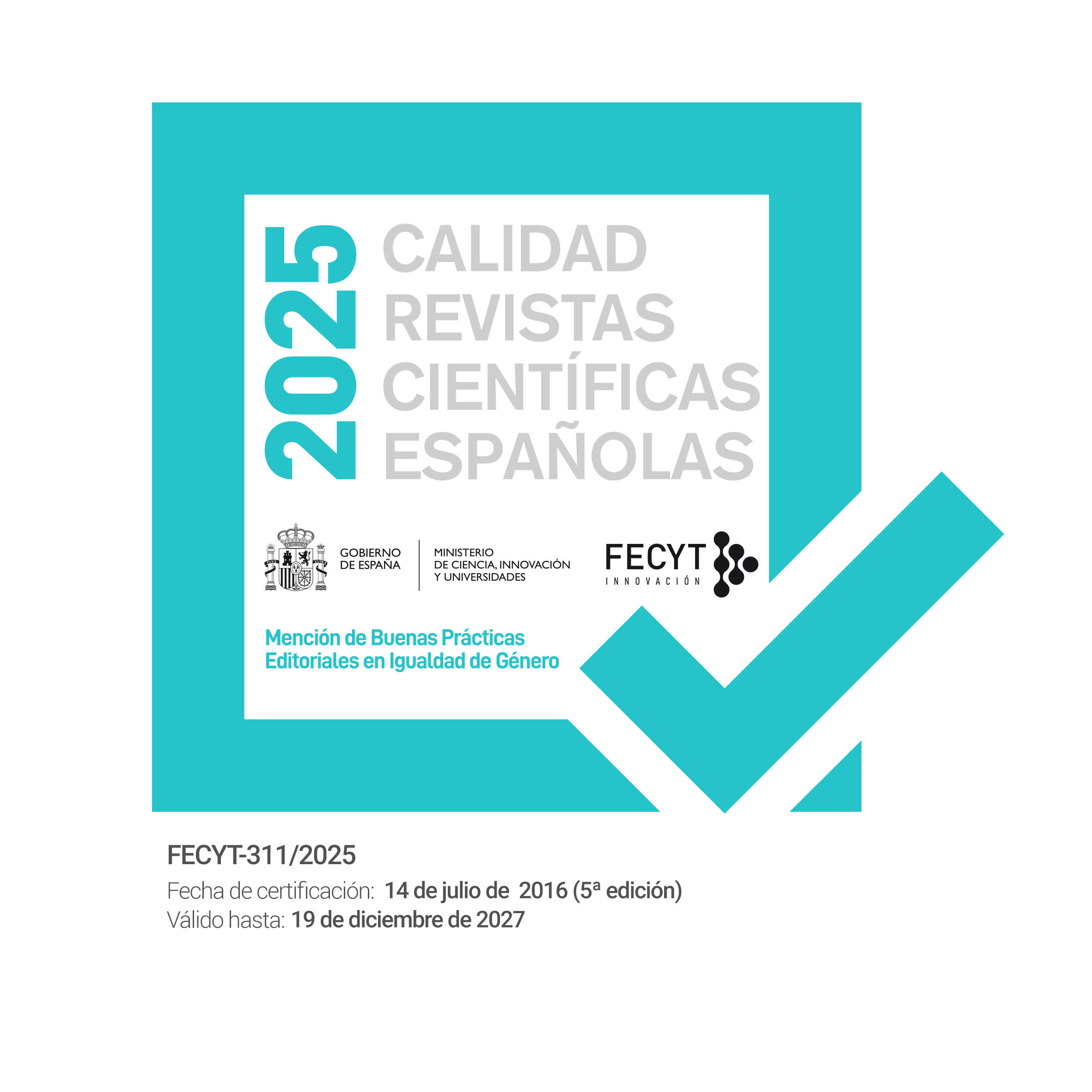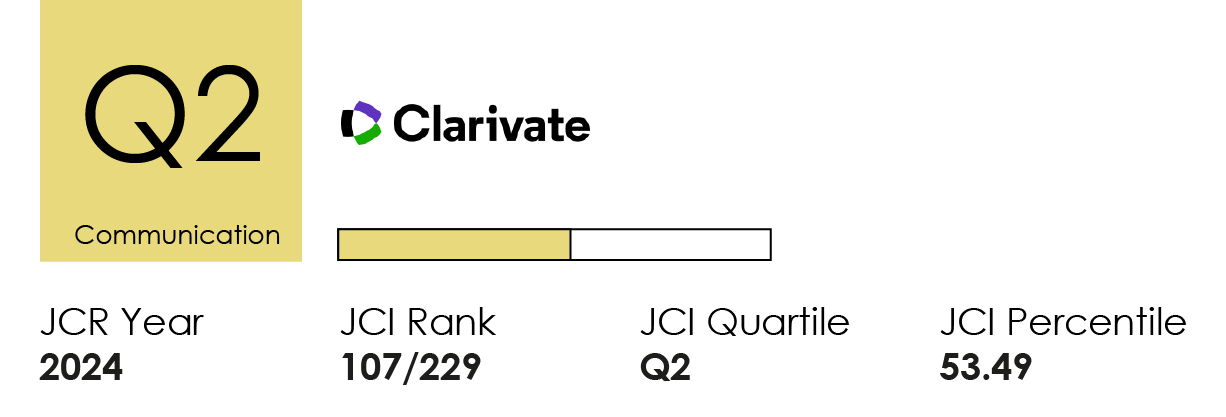Cobertura mediática del uso de la inteligencia artificial en el periodismo en España: relevancia, temas y frames
DOI:
https://doi.org/10.14198/MEDCOM.25169Palabras clave:
Artificial intelligence, framing, journalism, media, media coverage, Spain, Cobertura mediática, España, inteligencia artificial, medios de comunicación, periodismoResumen
La inteligencia artificial (IA) se ha convertido en un tema muy discutido debido a su implementación en muchas áreas, incluida la periodística. Se examina la cobertura de la IA periodística en medios escritos españoles, particularmente la relevancia otorgada, los temas tratados y el encuadre desde el que se aborda, mediante un análisis de contenido cuantitativo y un análisis estadístico. La IA periodística solo aparece como tema principal en un tercio de los casos, está cada vez más presente, se distribuye en más secciones y aparece principalmente en piezas escritas por periodistas de los medios. Predominan los textos informativos, pero son los periodistas quienes escriben la mayoría de los interpretativos y prácticamente todos los opinativos, promoviendo así el conocimiento y el debate público. Se ocupan principalmente de la aplicación más extendida de la IA, que es la automatización, muy por encima de los problemas laborales y éticos. La IA periodística suele enmarcarse más desde sus beneficios que de sus riesgos, pero recientemente se observan algunos cambios: una creciente preocupación por sus peligros e implicaciones éticas; la detección de abundantes piezas con encuadre personal, donde los periodistas hablan de su profesión y del uso de ChatGPT; y una creciente relevancia del encuadre episódico con el desarrollo de productos de IA. Este estudio podría haber examinado todo tipo de medios, aunque habría ido más allá de la naturaleza exploratoria de esta investigación pionera. Con este trabajo ampliamos la producción científica sobre IA periodística en España, donde esta perspectiva no ha sido analizada.
Citas
Albarrán Lozano, I., Molina, J. M., & Gijón, C. (2021). Perception of Artificial Intelligence in Spain. Telematics and Informatics, 63, 101672. http://doi.org/10.1016/j.tele.2021.101672
Beckett, C. (18/11/2019). New powers, new responsibilities: A global survey of journalism and artificial intelligence. Polis, London School of Economics and Political Science. https://tinyurl.com/bdhr4ywh
Brantner, C., & Saurwein, F. (2021). Covering Technology Risks and Responsibility: Automation, Artificial Intelligence, Robotics, and Algorithms in the Media. International Journal of Communication, 15, 5074-5098. https://bitly.ws/RxqL
Brennen, J. S. (2018). An industry-led debate: how UK media cover artificial intelligence. Reuters Institute for the Study of Journalism. https://bit.ly/40fEJo2
Brennen, J. S., Howard, P. N., & Nielsen, R. K. (2022). What to expect when you’re expecting robots: futures, expectations, and pseudo-artificial general intelligence in UK news. Journalism, 23(1), 22-38. http://doi.org/10.1177/1464884920947535
Calvo-Rubio, L. M., & Ufarte-Ruiz, M. J. (2020). Perception of teachers, students, innovation managers and journalists about the use of artificial intelligence in journalism. Profesional De La información, 29(1). http://doi.org/10.3145/epi.2020.ene.09
Cools, H., Van Gorp, B., & Opgenhaffen, M. (2022). Where exactly between utopia and dystopia? A framing analysis of AI and automation in US newspapers. Journalism. https://doi.org/10.1177/14648849221122647
Chan-Olmsted, S. M. (2019). A Review of Artificial Intelligence Adoptions in the Media Industry. International Journal on Media Management, 21(3-4), 193-215. http://doi.org/10.1080/14241277.2019.1695619
Chuan, C. H., Tsai, W. H. S., & Cho, S. Y. (2019). Framing artificial intelligence in American newspapers. In Proceedings of the 2019 AAAI/ACM Conference on AI, Ethics, and Society (pp. 339-344). Association for Computing Machinery (ACM). http://doi.org/10.1145/3306618.3314285
Dearing, J. W., & Rogers, E. M. (1996). Agenda-Setting. SAGE Publications. http://doi.org/10.4135/9781452243283
De-Lara, A. (2022). Retos de la divulgación de la inteligencia artificial en los cibermedios españoles. Contratexto, 38, 205-226. http://doi.org/10.26439/contratexto2022.n038.5701
Diakopoulos, N., & Koliska, M. (2017). Algorithmic Transparency in the News Media. Digital Journalism, 5(7), 809-828. http://doi.org/10.1080/21670811.2016.1208053
Dunwoody, S. (2014). Science journalism. In M. Bucchi, & B. Trench (Eds.), Routledge Handbook of Public Communication of Science and Technology (pp. 27-39). Routledge.
Entman, R. M. (1993). Framing: Toward Clarification of a Fractured Paradigm. Journal of Communication, 43(4), 51-58. http://doi.org/10.1111/j.1460-2466.1993.tb01304.x
García-Orosa, B., Canavilhas, J., & Vázquez-Herrero, J. (2023). Algoritmos y comunicación: Revisión sistematizada de la literatura. Comunicar: Revista Científica de Comunicación y Educación, 31(74), 9-21. http://doi.org/10.3916/C74-2023-01
Graefe, A. (2016). Guide to automated journalism. Tow Center for Digital Journalism.
Grimme, M. (2021). Factors Influencing the Rejection of Automated Journalism: A Systematic Literature Review. Nordic Journal of Media Management, 2(1), 3-21. http://doi.org/10.5278/njmm.2597-0445.6826
Gurr G., & Metag, J. (2023). Content Analysis in the Research Field of Technology Coverage. In F. Oehmer-Pedrazzi, S. Heike Kessler, E. Humprecht, K. Sommer, & L. Castro (Eds.), Standardisierte Inhaltsanalyse in der Kommunikationswissenschaft–Standardized Content Analysis in Communication Research (pp. 239-247). Springer.
Hansen, S. (2022). Public AI imaginaries: How the debate on artificial intelligence was covered in Danish newspapers and magazines 1956–2021. Nordicom Review, 43(1), 56-78. http://doi.org/10.2478/nor-2022-0004
Jacobs, R. N., & Townsley, E. (2011). The Space of Opinion: Media Intellectuals and the Public Sphere. Oxford University Press.
JournalismAI. (2022). AIJournalism Starter Pack. Polis, London School of Economics and Political Science. https://bit.ly/41tqTzn
Kowach, B., & Rosenstiel, T. (2001). The Elements of Journalism: What Newspeople Should Know and the Public Should Expect. Crown Publishers.
Kreiss, D. (2016). Beyond Administrative Journalism: Civic Skepticism and the Crisis in Journalism. In J. C. Alexander, E. Butler Breese, & M. Luengo (Eds.), The Crisis of Journalism Reconsidered: Democratic Culture, Professional Codes, Digital Future (pp. 59-76). Cambridge University Press.
Lupton, D. (2021). 'Flawed', 'cruel' and 'irresponsible': the framing of automated decision-making technologies in the Australian press: a discussion paper. http://doi.org/10.2139/ssrn.3828952
Martín-Holguín, L. (2018). Communicating Artificial Intelligence through Newspapers: Where is the Real Danger? [Graduation Thesis, Leiden University]. https://bit.ly/3GLtxsG
Sun, M., Hu, W., & Wu, Y. (2022). Public Perceptions and Attitudes Towards the Application of Artificial Intelligence in Journalism: From a China-based Survey. Journalism Practice, 1-23. http://doi.org/10.1080/17512786.2022.2055621
Moran, R. E., & Jawaid Shaikh, S. (2022). Robots in the News and Newsrooms: Unpacking Meta-Journalistic Discourse on the Use of Artificial Intelligence in Journalism. Digital Journalism, 10(10), 1756-1774. http://doi.org/10.1080/21670811.2022.2085129
Newman, N. (2022). Journalism, Media, and Technology Trends and Predictions 2022. Reuters Institute-University of Oxford. https://bit.ly/41uXWmJ
Nguyen, D., & Hekman, E. (2022a). A ‘New Arms Race’? Framing China and the USA in AI News Reporting: A Comparative Analysis of the Washington Post and South China Morning Post. Global Media and China, 7(1), 58-77. http://doi.org/10.1177/20594364221078626
Nguyen, D., & Hekman, E. (2022b). The news framing of artificial intelligence: a critical exploration of how media discourses make sense of automation. AI & SOCIETY. http://doi.org/10.1007/s00146-022-01511-1
Owsley, C. S., & Greenwood, K. (2022). Awareness and perception of artificial intelligence operationalized integration in news media industry and society. AI & SOCIETY. http://doi.org/10.1007/s00146-022-01386-2
Page, B. I., Shapiro, R. Y., & Dempsey, G. R. (1987). What Moves Public Opinion? The American Political Science Review, 81(1), 23-44. http://doi.org/10.2307/1960777
Parratt-Fernández, S., Mayoral-Sánchez, J., & Mera-Fernández, M. (2021). The application of artificial intelligence to journalism: an analysis of academic production. Profesional De La información, 30(3). http://doi.org/10.3145/epi.2021.may.17
Parratt-Fernández, S., Chaparro-Domínguez, M. Á., & Gilbert, G. S. (2022). Discursive Strategies for Climate Change Reporting: A Case Study of The Mercury News. Environmental Communication, 16(4), 505-519. http://doi.org/10.1080/17524032.2022.2048043
Picard, R.G. (2004). Commercialism and Newspaper Quality. Newspaper ResearchJournal, 25(1), 54-66.
Rowan, K. E. (2003). Informing and explaining skills: Theory and research on informative communication. In J. O. Green, & B. R. Burleson (Eds.), Handbook of communication and social interaction skills (pp. 403-438). Laurence Erlbaum.
Salgado, S., & Strömbäck, J. (2012). Interpretive Journalism: A Review of Concepts, Operationalizations, and Key Findings. Journalism, 13(2), 144-161. http://doi.org/10.1177/1464884911427797
Schäfer, M. S. (2017). How Changing Media Structures Are Affecting Science News Coverage. In K. Hall Jamieson, D. Kahan, & D. A. Scheufele (Eds.), The Oxford Handbook of the Science of Science Communication (pp. 51-60). Oxford University Press.
Schnizlein, J., & Steinlechner, D. (2016). Nicht ein Wort stimmt [Not a word is true]. News, 43, 22–28.
Suerdem, A., & Akkilic, S. (2021). Cultural Differences in Media Framing of AI. In B. Schiele, X. Liu, & M. W. Bauer (Eds.), Science Cultures in a Diverse World: Knowing, Sharing, Caring (pp. 185-207). Springer. http://doi.org/10.1007/978-981-16-5379-7_10
The Financial Times. (08/02/2023). Financial Times appoints Madhumita Murgia as its first Artificial Intelligence editor. The Financial Times. http://bitly.ws/Eof9
Thomas, R. J. (2018). Advocacy Journalism. In T. P. Vos (Ed.), Journalism (pp. 391-413). Walter de Gruyter.
Thurman, N. (2019). Computational journalism. In K. Wahl-Jorgensen & T. Hanitzsch (Eds.), The handbook of Journalism Studies (pp. 180-195). Routledge.
Thurman, N., Dörr, K., & Kunert, J. (2017). When Reporters Get Hands-on with Robo-Writing: Professionals consider automated journalism’s capabilities and consequences. Digital Journalism, 5(10), 1240-1259. http://doi.org/10.1080/21670811.2017.1289819
Túñez-López, J.-M., Toural-Bran, C., & Cacheiro-Requeijo, S. (2018). Automated-content generation using news-writing bots and algorithms: Perceptions and attitudes amongst Spain’s journalists. Profesional De La información, 27(4), 750–758. http://doi.org/10.3145/epi.2018.jul.04
Xu, Z., & Lan, X. (2020). A scientometric review of automated journalism: Analysis and visualization. Journal of physics, 1684(1). http://doi.org/10.1088/1742-6596/1684/1/012127
Ziegler, L. D. (2015). Computational journalism: Shaping the future of news in a big data world. In W. J. Gibbs, & J. McKendrick (Eds.), Contemporary Research Methods and Data Analytics in the News Industry (pp. 17-31). IGI Global.
Descargas
Estadísticas
Publicado
Cómo citar
Número
Sección
Licencia
Derechos de autor 2024 Isabel-María Martín-Sánchez, Sonia Parratt-Fernández, María-Ángeles Chaparro-Domínguez

Esta obra está bajo una licencia internacional Creative Commons Atribución 4.0.
Los autores y autoras que publican en esta revista están de acuerdo con los siguientes términos:
1 Derechos de autor. Los autores y autoras conservan sus derechos de autor, aunque ceden a la revista de forma no exclusiva los derechos de explotación (reproducción, distribución, comunicación pública y transformación) y garantizan a esta el derecho de primera publicación de su trabajo, el cual estará simultáneamente sujeto a la licencia indicada en punto 2. Los autores pueden establecer otros acuerdos adicionales para la distribución no exclusiva de la versión de la obra publicada en la revista, siempre que exista un reconocimiento de su publicación inicial en esta revista.
© Los autores.
2 Licencia. Los trabajos se publican en la revista sujetos a la licencia de Reconocimiento 4.0 Internacional de Creative Commons (CC BY 4.0); los términos se pueden consultar en https://creativecommons.org/licenses/by/4.0/
Esta licencia permite a terceros compartir (copiar y redistribuir el material en cualquier medio o formato) y adaptar (remezclar, transformar y crear a partir del material para cualquier finalidad, incluso comercial), siempre que se reconozca la autoría y la primera publicación en esta revista (Revista Mediterránea de Comunicación (RMC) / Mediterranean Journal of Communication (MJC), Universidad de Alicante, DOI de la obra), se proporcione un enlace a la licencia y se indique si se han realizado cambios en la obra.
3 Política de autoarchivo. Se recomienda a los autores que difundan sus trabajos a través de Internet para favorecer una circulación y difusión más rápidas y, con ello, un posible aumento en la citación y alcance entre la comunidad científica y académica, en las siguientes condiciones:
No se permite a los autores depositar en un repositorio institucional o temático, página web propia, etc., las versiones preprint (versión antes de ser evaluada) o postprint (versión evaluada y aceptada para su publicación) de sus trabajos antes de su publicación, pero sí el artículo final publicado (versión del editor).













